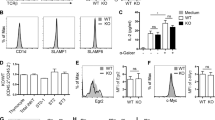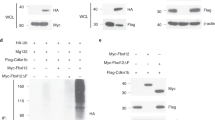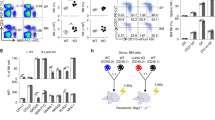Abstract
Activation of natural killer (NK) cells by hematopoietic target cells is controlled by the SLAM family of receptors and by the associated SAP family of adaptors. Here we found that SLAM receptors also enhanced NK cell activation by nonhematopoietic target cells, which lack ligands for SLAM receptors. This function was mediated by SLAMF6, a homotypic SLAM receptor found on NK cells and other hematopoietic cells, and was regulated by SAP adaptors, which uncoupled SLAM receptors from phosphatase SHP-1 and diminished the effect of SLAMF6 on NK cell responsiveness toward nonhematopoietic cells. Thus, in addition to their role in NK cell activation by hematopoietic cells, the SLAM-SAP pathways influence responsiveness toward nonhematopoietic targets by a process akin to NK cell 'education'.
This is a preview of subscription content, access via your institution
Access options
Subscribe to this journal
Receive 12 print issues and online access
$209.00 per year
only $17.42 per issue
Buy this article
- Purchase on Springer Link
- Instant access to full article PDF
Prices may be subject to local taxes which are calculated during checkout








Similar content being viewed by others
References
Bryceson, Y.T. & Long, E.O. Line of attack: NK cell specificity and integration of signals. Curr. Opin. Immunol. 20, 344–352 (2008).
Lanier, L.L. NK cell recognition. Annu. Rev. Immunol. 23, 225–274 (2005).
Vivier, E., Tomasello, E., Baratin, M., Walzer, T. & Ugolini, S. Functions of natural killer cells. Nat. Immunol. 9, 503–510 (2008).
Shifrin, N., Raulet, D.H. & Ardolino, M. NK cell self tolerance, responsiveness and missing self recognition. Semin. Immunol. 26, 138–144 (2014).
Höglund, P. & Brodin, P. Current perspectives of natural killer cell education by MHC class I molecules. Nat. Rev. Immunol. 10, 724–734 (2010).
Orr, M.T. & Lanier, L.L. Natural killer cell education and tolerance. Cell 142, 847–856 (2010).
Elliott, J.M. & Yokoyama, W.M. Unifying concepts of MHC-dependent natural killer cell education. Trends Immunol. 32, 364–372 (2011).
Deng, W. et al. Antitumor immunity. A shed NKG2D ligand that promotes natural killer cell activation and tumor rejection. Science 348, 136–139 (2015).
Anfossi, N. et al. Human NK cell education by inhibitory receptors for MHC class I. Immunity 25, 331–342 (2006).
Kim, S. et al. Licensing of natural killer cells by host major histocompatibility complex class I molecules. Nature 436, 709–713 (2005).
Fernandez, N.C. et al. A subset of natural killer cells achieves self-tolerance without expressing inhibitory receptors specific for self-MHC molecules. Blood 105, 4416–4423 (2005).
Tripathy, S.K. et al. Continuous engagement of a self-specific activation receptor induces NK cell tolerance. J. Exp. Med. 205, 1829–1841 (2008).
Oppenheim, D.E. et al. Sustained localized expression of ligand for the activating NKG2D receptor impairs natural cytotoxicity in vivo and reduces tumor immunosurveillance. Nat. Immunol. 6, 928–937 (2005).
Viant, C. et al. SHP-1–mediated inhibitory signals promote responsiveness and anti-tumour functions of natural killer cells. Nat. Commun. 5, 5108 (2014).
Chalifour, A. et al. A role for cis interaction between the inhibitory Ly49A receptor and MHC class I for natural killer cell education. Immunity 30, 337–347 (2009).
Veillette, A. SLAM-family receptors: immune regulators with or without SAP-family adaptors. Cold Spring Harb. Perspect. Biol. 2, a002469 (2010).
Cannons, J.L., Tangye, S.G. & Schwartzberg, P.L. SLAM family receptors and SAP adaptors in immunity. Annu. Rev. Immunol. 29, 665–705 (2011).
Detre, C., Keszei, M., Romero, X., Tsokos, G.C. & Terhorst, C. SLAM family receptors and the SLAM-associated protein (SAP) modulate T cell functions. Semin. Immunopathol. 32, 157–171 (2010).
Veillette, A., Perez-Quintero, L.A. & Latour, S. X-linked lymphoproliferative syndromes and related autosomal recessive disorders. Curr. Opin. Allergy Clin. Immunol. 13, 614–622 (2013).
Tangye, S.G. XLP: clinical features and molecular etiology due to mutations in SH2D1A encoding SAP. J. Clin. Immunol. 34, 772–779 (2014).
Roncagalli, R. et al. Negative regulation of natural killer cell function by EAT-2, a SAP-related adaptor. Nat. Immunol. 6, 1002–1010 (2005).
Dong, Z. et al. Essential function for SAP family adaptors in the surveillance of hematopoietic cells by natural killer cells. Nat. Immunol. 10, 973–980 (2009).
Dong, Z. et al. The adaptor SAP controls NK cell activation by regulating the enzymes Vav-1 and SHIP-1 and by enhancing conjugates with target cells. Immunity 36, 974–985 (2012).
Parolini, S. et al. X-linked lymphoproliferative disease. 2B4 molecules displaying inhibitory rather than activating function are responsible for the inability of natural killer cells to kill Epstein-Barr virus-infected cells. J. Exp. Med. 192, 337–346 (2000).
Bottino, C. et al. GNTB-A, a novel SH2D1A-associated surface molecule contributing to the inability of natural killer cells to kill Epstein-Barr virus-infected B cells in X-linked lymphoproliferative disease. J. Exp. Med. 194, 235–246 (2001).
Bloch-Queyrat, C. et al. Regulation of natural cytotoxicity by the adaptor SAP and the Src-related kinase Fyn. J. Exp. Med. 202, 181–192 (2005).
Pérez-Quintero, L.A. et al. EAT-2, a SAP-like adaptor, controls NK cell activation through phospholipase Cγ, Ca++, and Erk, leading to granule polarization. J. Exp. Med. 211, 727–742 (2014).
Cruz-Munoz, M.E., Dong, Z., Shi, X., Zhang, S. & Veillette, A. Influence of CRACC, a SLAM family receptor coupled to the adaptor EAT-2, on natural killer cell function. Nat. Immunol. 10, 297–305 (2009).
Veillette, A. NK cell regulation by SLAM family receptors and SAP-related adapters. Immunol. Rev. 214, 22–34 (2006).
Wandstrat, A.E. et al. Association of extensive polymorphisms in the SLAM/CD2 gene cluster with murine lupus. Immunity 21, 769–780 (2004).
Joncker, N.T., Shifrin, N., Delebecque, F. & Raulet, D.H. Mature natural killer cells reset their responsiveness when exposed to an altered MHC environment. J. Exp. Med. 207, 2065–2072 (2010).
Elliott, J.M., Wahle, J.A. & Yokoyama, W.M. MHC class I–deficient natural killer cells acquire a licensed phenotype after transfer into an MHC class I–sufficient environment. J. Exp. Med. 207, 2073–2079 (2010).
Zhang, Z. et al. DNAM-1 controls NK cell activation via an ITT-like motif. J. Exp. Med. 212, 2165–2182 (2015).
Nimmerjahn, F. & Ravetch, J.V. Fcγ receptors as regulators of immune responses. Nat. Rev. Immunol. 8, 34–47 (2008).
Nabekura, T. et al. Costimulatory molecule DNAM-1 is essential for optimal differentiation of memory natural killer cells during mouse cytomegalovirus infection. Immunity 40, 225–234 (2014).
Shibuya, K. et al. Physical and functional association of LFA-1 with DNAM-1 adhesion molecule. Immunity 11, 615–623 (1999).
Zhong, M.C. & Veillette, A. Control of T lymphocyte signaling by Ly108, a signaling lymphocytic activation molecule family receptor implicated in autoimmunity. J. Biol. Chem. 283, 19255–19264 (2008).
Gumbleton, M., Vivier, E. & Kerr, W.G. SHIP1 intrinsically regulates NK cell signaling and education, resulting in tolerance of an MHC class I–mismatched bone marrow graft in mice. J. Immunol. 194, 2847–2854 (2015).
Stebbins, C.C. et al. Vav1 dephosphorylation by the tyrosine phosphatase SHP-1 as a mechanism for inhibition of cellular cytotoxicity. Mol. Cell. Biol. 23, 6291–6299 (2003).
Guia, S. et al. Confinement of activating receptors at the plasma membrane controls natural killer cell tolerance. Sci. Signal. 4, ra21 (2011).
Sivori, S. et al. Early expression of triggering receptors and regulatory role of 2B4 in human natural killer cell precursors undergoing in vitro differentiation. Proc. Natl. Acad. Sci. USA 99, 4526–4531 (2002).
Lee, J. et al. Epigenetic modification and antibody-dependent expansion of memory-like NK cells in human cytomegalovirus–infected individuals. Immunity 42, 431–442 (2015).
Schlums, H. et al. Cytomegalovirus infection drives adaptive epigenetic diversification of NK cells with altered signaling and effector function. Immunity 42, 443–456 (2015).
Zhong, M.C. & Veillette, A. The adaptor molecule signaling lymphocytic activation molecule (SLAM)-associated protein (SAP) is essential in mechanisms involving the Fyn tyrosine kinase for induction and progression of collagen-induced arthritis. J. Biol. Chem. 288, 31423–31436 (2013).
Davidson, D., Shi, X., Zhong, M.C., Rhee, I. & Veillette, A. The phosphatase PTP-PEST promotes secondary T cell responses by dephosphorylating the protein tyrosine kinase Pyk2. Immunity 33, 167–180 (2010).
Pachlopnik Schmid, J. et al. Clinical similarities and differences of patients with X-linked lymphoproliferative syndrome type 1 (XLP-1/SAP deficiency) versus type 2 (XLP-2/XIAP deficiency). Blood 117, 1522–1529 (2011).
Rigaud, S. et al. XIAP deficiency in humans causes an X-linked lymphoproliferative syndrome. Nature 444, 110–114 (2006).
Veillette, A., Bookman, M.A., Horak, E.M. & Bolen, J.B. The CD4 and CD8 T cell surface antigens are associated with the internal membrane tyrosine-protein kinase p56lck. Cell 55, 301–308 (1988).
Acknowledgements
A.V. holds the Canada Research Chair in Signaling in the Immune System. We thank the members of A.V.'s lab for discussions. We acknowledge L. Yin for the SAP-KO mouse. Supported by grants from the Canadian Institutes of Health Research (CIHR) (to A.V.), the China-Canada Joint Health Research Initiative (to A.V. and Z.D.) and the Canadian Cancer Society Research Institute (CCSRI) (to A.V.). N.W. received a fellowship from Fonds de la Recherche du Québec – Santé (FRQS). R.R. received a studentship from CCSRI. L.-A.P.-Q. received a studentship from Institut de Recherches Cliniques de Montréal. Z.D. received a postdoctoral fellowship from CIHR.
Author information
Authors and Affiliations
Contributions
N.W. planned and performed experiments, interpreted data and wrote the manuscript. M.-C.Z., R.R., L.-A.P.-Q., H.G., C.L., Z.D. and Z.Z. planned and performed experiments, generated reagents and interpreted data. S.L. planned and performed experiments, interpreted data and provided reagents. A.V. planned experiments, generated reagents, interpreted data, wrote the manuscript and obtained funding.
Corresponding author
Ethics declarations
Competing interests
The authors declare no competing financial interests.
Integrated supplementary information
Supplementary Figure 1 Impact of SAP adaptors on mouse NK cell cytotoxicity towards nonhematopoietic cells.
(a) Expression of SLAM receptors and CD48 on splenic NK cells from wild-type (WT) and SAP-deficient (SAP KO) mice in 129S1/Sv background. NK cells were identified as NKp46+CD3- cells. Blue line, receptor-specific antibody; red line, isotype control. (b,c) Natural cytotoxicity by IL-2-activated NK cells (“LAK” cells) from WT, SAP KO (b) or EAT-2 ERT double KO (DKO; c) mice was determined using a 51Cr release assay at the indicated effector-to-target (E:T) ratio. Percentage (%) of maximum 51Cr release is shown. Average values of duplicates are shown; error bars depict standard deviations. Representative of 2 (a) and 3 (b,c) independent experiments.
Supplementary Figure 2 Expression of SLAM receptors.
Expression of SLAM receptors and CD48 on HeLa and K562 cells was determined by flow cytometry. Blue line, receptor-specific antibody; filled histogram, isotype control. Representative of 2 independent experiments.
Supplementary Figure 3 Generation of mice lacking CD48, SLAMF6 or Ly-9.
The exon-intron structure of the genes encoding CD48 (Slamf2; a), SLAMF6 (Slamf6; b) and Ly-9 (Slamf3; c) in the mouse is shown at the top of each panel. Exon 1 contains the initiating ATG (right-sided arrow), while a downstream exon bears the stop codon (left-sided arrow). The targeting construct is shown below. For Slamf2 and Slamf3, the construct allows disruption and introduction of a stop codon (TGA) in exon 1. For Slamf6, it enables deletion of exons 2-4. This deletion is expected to remove both immunoglobulin-like domains and the transmembrane region. The middle fragment, which contains the neomycin resistance gene (neor) cassette, is bordered by frt sites (diamonds). The targeted allele containing the neor cassette is depicted below. The neor-deleted allele, which was generated by transient expression of the Flpe recombinase, is shown at the bottom.
Supplementary Figure 4 Expression of SLAM receptors and SAP during NK cell development.
Expression of SLAMF6 (a) and SAP (b) in various sub-populations of splenic NK cells was assessed in C57BL/6 mice, as detailed for Figure 5k. NKP, NK precursors; iNK-1, stage 1 immature NK cells; iNK-2, stage 2 immature NK cells; mNK, mature NK cells. Shaded histograms represent isotype controls. A graphic representation of mean fluorescent intensity (MFI) at the various stages is depicted on the right. Closed symbols: staining with receptor-specific antibodies. Open symbols: staining with isotype controls. (c,d) Expression of the other SLAM family receptors, as well as CD48, was assessed on splenic NK cell subsets from 129S1/Sv (c) or C57BL/6 (d) mice, as detailed for (a,b). Representative of 3 independent experiments are shown in (a, b, c, d).
Supplementary Figure 5 Ectopic expression of mouse SLAMF6 in YT-S cells.
(a) Expression of mouse SLAMF6 isoform 1 (mSLAMF6-1) and 2 (mSLAMF6-2) on YT-S cells was determined by flow cytometry. Cells expressing empty vector were used as control (CT). (b,c) Natural cytotoxicity towards HeLa or K562 by YT-S-mSLAMF6-2 cells transfected with control siRNA (siCT) or SAP-specific siRNA (siSAP), at different effector-to-target (E:T) ratios. A representative experiment is shown in (b), whereas statistical analyses of data from multiple independent experiments at the 25:1 E:T ratio are shown in (c). Standard deviations are depicted by error bars in (b). Error bars represent sem in (c). Data are representative of 3 (a) and 4 (b,c) independent experiments.
Supplementary Figure 6 Role of SLAMF6 on NK cell education.
(a) Expression of SLAM receptors and other NK cell markers on parental and SLAMF6-deficient (KO) YT-S cells was determined by flow cytometry. SLAMF6 KO YT-S cells were generated using three different targeting vectors (named 1-3). (b,c) Natural cytotoxicity of parental or SLAMF6 KO YT-S cells towards HeLa and K562, expressing or not human SLAMF6 (b) or CD48 (c). Assays were performed as detailed for Figure 6a. (d) Splenocytes described in Figure 6h were stimulated overnight with plate-bound anti-Ly49D antibodies. Production of IFN-γ by SAP KO NK cells was then determined by intracellular staining and gating on CFSE+DX5+CD3- cells. A representative experiment is shown on the left. Numbers in the box indicate percentages (%) of IFN-γ+ cells. Statistical analyses of the increase in IFN-γ+ cells, between cells stimulated with anti-Ly49D and those stimulated with medium alone, in multiple independent experiments (n=7) are shown on the right. (e) YT-S cells expressing mouse DNAM-1 (mDNAM-1) were mixed with parental or SLAMF6 KO YT-S cells at the ratio 1:15. After 3 weeks, the percentages of mDNAM-1-positive YT-S cells in the mixtures were determined by flow cytometry using mouse anti-DNAM-1 antibodies (upper panel). YT-S cells were then stimulated with anti-mDNAM-1 antibodies, and calcium flux was assessed (lower panel). Data are representative of 2 (a), 3 (b,c), 7 (d), and 3 (e) independent experiments. Unpaired t test (n=7) was used for d. NS, not significant.
Supplementary information
Supplementary Text and Figures
Supplementary Figures 1–6 and Supplementary Tables 1 and 2 (PDF 1216 kb)
Rights and permissions
About this article
Cite this article
Wu, N., Zhong, MC., Roncagalli, R. et al. A hematopoietic cell–driven mechanism involving SLAMF6 receptor, SAP adaptors and SHP-1 phosphatase regulates NK cell education. Nat Immunol 17, 387–396 (2016). https://doi.org/10.1038/ni.3369
Received:
Accepted:
Published:
Issue Date:
DOI: https://doi.org/10.1038/ni.3369
This article is cited by
-
Dysfunctional natural killer cells can be reprogrammed to regain anti-tumor activity
The EMBO Journal (2024)
-
Plasma membrane lipid scrambling causing phosphatidylserine exposure negatively regulates NK cell activation
Cellular & Molecular Immunology (2021)
-
Interaction kinetics with transcriptomic and secretory responses of CD19-CAR natural killer-cell therapy in CD20 resistant non-hodgkin lymphoma
Leukemia (2020)
-
NK cell recognition of hematopoietic cells by SLAM-SAP families
Cellular & Molecular Immunology (2019)
-
SLAM receptors foster iNKT cell development by reducing TCR signal strength after positive selection
Nature Immunology (2019)



